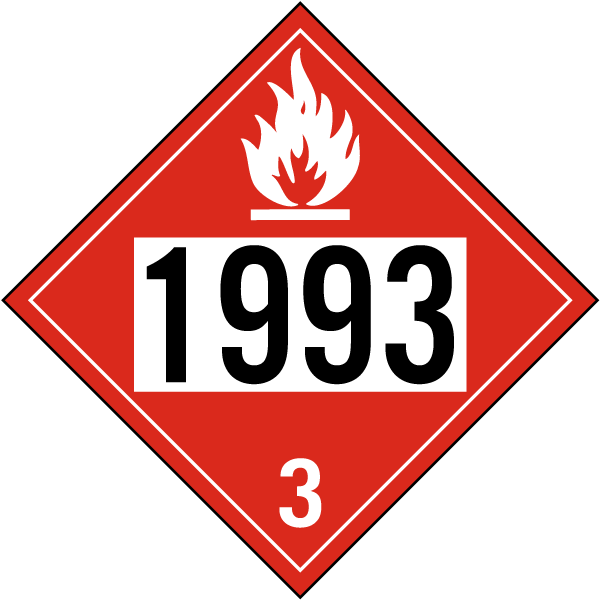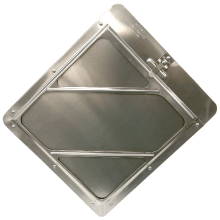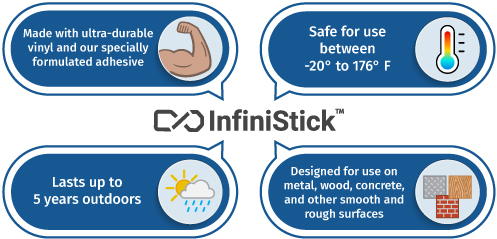- Item #
- K5609-JQ
- Compliance
-
- Code of Federal Regulations
- ECCN Certification
- OSHA 1910.1200(c)
Recommended Accessories
Product Information
Details
A UN # 1993 Class 3 Flammable Liquid has safety text and/or images for chemical safety protocol and compliance. A UN # 1993 Class 3 Flammable Liquid is a helpful resource to help protect the health and safety of personnel, and is not a substitute for required protective measures for reducing or eliminating hazards.
About InfiniStick™ Labels
We engineered our InfiniStick™ labels for maximum adhesiveness and durability. InfiniStick™ labels are made with Brimar’s specially formulated adhesive and ultra-durable vinyl and can withstand the most challenging conditions without peeling off. Safe for use between -20° to 176° F and capable of sticking to a wide range of smooth and rough surfaces, InfiniStick™ labels are ideal for nearly any application.
InfiniStick™ labels adhere to a wide range of surfaces, making them perfect for use outdoors, in industrial settings, on machines, containers, vehicles, and more. For maximum adhesion, simply wipe the surface clean, remove the film from the label, and stick.
Thanks to their durability and versatility, InfiniStick™ labels will remain in place and effective for years, saving you money compared to standard labels, which must be replaced more frequently. Whether your label contains a safety warning, hazard rating, or any other directive, you can count on the resilience of labels made with InfiniStick™ technology.
Compliance
DOT Placards
1910 OSHA: Toxic and Hazardous Substances 1910.1201 Title: Retention of DOT markings, placards and labels.
- 1910.1201(a)
- Any employer who receives a package of hazardous material which is required to be marked, labeled or placarded in accordance with the U. S. Department of Transportation's Hazardous Materials Regulations (49 CFR Parts 171 through 180) shall retain those markings, labels and placards on the package until the packaging is sufficiently cleaned of residue and purged of vapors to remove any potential hazards.
- 910.1201(b)
- Any employer who receives a freight container, rail freight car, motor vehicle, or transport vehicle that is required to be marked or placarded in accordance with the Hazardous Materials Regulations shall retain those markings and placards on the freight container, rail freight car, motor vehicle or transport vehicle until the hazardous materials which require the marking or placarding are sufficiently removed to prevent any potential hazards.
- 1910.1201(c)
- Markings, placards and labels shall be maintained in a manner that ensures that they are readily visible.
- 1910.1201(d)
- For non-bulk packages which will not be reshipped, the provisions of this section are met if a label or other acceptable marking is affixed in accordance with the Hazard Communication Standard (29 CFR 1910.1200).
- 1910.1201(e)
- For the purposes of this section, the term "hazardous material" and any other terms not defined in this section have the same definition as in the Hazardous Materials Regulations (49 CFR Parts 171 through 180).
Placard Construction:
- Transporting hazardous materials that meet DOT requirements are marked with warning placards. The placards are 10-3/4” x 10-3/4” and must be on all four sides of the vehicle.
- Each placard includes the color, symbol, and name of the class into which the hazard falls.
- Included with the DOT placards are United Nations identification numbers specific to each transported substance.
- The numbers are displayed inside the placard or in an orange rectangle immediately below the placard.
Identifying DOT Placards
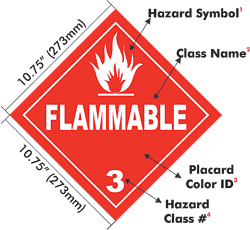
- The Hazard Symbol
- is another means of identifying the placard. A variety of symbols are used to indicate combustion, radiation, oxidizers, compressed gas, destruction of materials and skin by corrosives, an explosion, or skull and cross bones to indicate poisons.
- Class Name
- Hazardous materials have been classified under 9 classes. See detailed description below.
- Placard Color
- Click here to view color classification image.
- Hazard Class #
- This number refers to the hazard classes as used internationally and by the United States DOT.
4-Digit DOT Placards
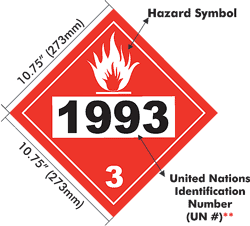
** This 4-Digit United Nations (UN) number is used to identify the hazardous material contained in the container. There are hundreds of four digit numbers used, from 1001 (acetylene) to 9279 (hydrogen, absorbed in metal hydride). The number in some cases is specific to a chemical and in other cases reflects a variety of hazardous materials. (For example, 1017 is only used for chlorine, 1005 has five chemical listings, 1993 is used for eight chemical listings and 2810 is used for 36 chemical listings.)
DOT Placard Classification
The US DOT divides hazardous materials into 9 major hazard classes. A hazard class is a group of materials that share a common major hazardous property (example: Flammable Liquids, Gases, Corrosive, Toxic/Poison, etc.) Below you’ll see the different placards we carry broken down by individual classes.
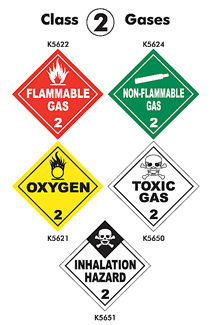
Hazardous Class 2: Gases
- Division 2.1 (Flammable Gas)
- is a gas which will readily ignite at a concentration of 13 % of less in air and has a flammable range of at least 12% regardless of the lower flammability limit. Example: Flammable gases: Hydrogen, Propane, Silane.
- Division 2.2 (Non-Flammable Gas)
- is a gas which can ignite under some conditions, is not classed as a flammable gas, because it does not meet the DOT requirements for being classified as a flammable gas. Example: Non-Flammable gases: Nitrogen, Carbon dioxide, etc.
- Division 2.3 (Poisonous Gas)
- is a gas which is known to be so toxic to humans as to pose a hazard to health during transportation or for which actual testing has shown that the lethal concentration which kills 50% of the test animals (LC50) is less than or equal to 5000 ml/m3 (0.5% by volume in air). example: Poisonous gases: Hydrogen sulfide, Hydrogen cyanide, Arsine.
Hazard Class 3 Flammable Liquids Hazard Class 3 Combustible Liquids
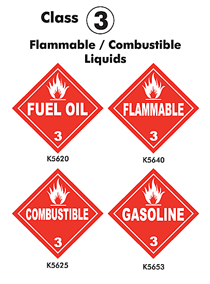
- Flammable Liquid
- Liquid chemical which will readily ignite, if subjected to a flame, or other ignition source. A flammable liquid (Class 3) means a liquid having a flash point of not more than 60.5°C (141°F), or any material in a liquid phase with a flash point at or above 37.8°C (100°F) that is intentionally heated and offered for transportation or transported at or above its flash point in a bulk packaging, with some exceptions. Example: Gasoline, Hexane, Toluene.
- Combustible liquids
- are a subset of flammable liquids, and ignite, but not as easily as flammable liquids. The flash point of a combustible liquid is between 38°C (100°F) and 93°C (200°F). Diesel fuel is usually a combustible liquid.
Hazard Class 4: Flammable Solids
Flammable solids are solids which readily ignite under appropriate conditions, which may include exposure to air or water, friction, or an ignition source.
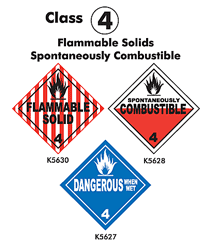
- Division 4.1 (Flammable Solid)
- includes certain explosives which have been wetted with water or alcohol and are not sensitive to explosion, but can ignite and burn; and chemicals which are specifically assigned to Division 4.1 by the DOT.
- Division 4.2 (Spontaneously Combustible Material)
- means a pyrophoric material or a self-heating material. Lithium alkyls are an example of a pyrophoric material (a chemical which spontaneously ignites when exposed to air) in Division 4.2.
- Division 4.3 (Dangerous when wet material)
- means a material that, by contact with water, is liable to become spontaneously flammable or to give off flammable or toxic gas at a rate greater than 1 liter per kilogram of the material, per hour. example: Sodium, Potassium, and Lithium hydride.
Hazard Class 5: Oxidizer & Organic Peroxide
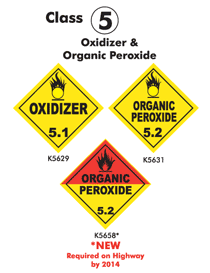
- An OXIDIZER (Division 5.1) is a substance that yields oxygen readily to stimulate the combustion of other materials.
- An ORGANIC PEROXIDE (Division 5.2) means any organic compound containing oxygen (O) in the bivalent -O-O- structure and which may be considered a derivative of hydrogen peroxide, where one or more of the hydrogen atoms have been replaced by organic radicals.
- *The new ORGANIC PEROXIDE (Division 5.1) placard becomes mandatory 1 January 2011 for transportation by rail, vessel, or aircraft and 1 January 2014 for transportation by highway. The placard will enable transport workers to readily distinguish peroxides from oxidizers.
Hazard Class 6: Toxic & Infectious Substances
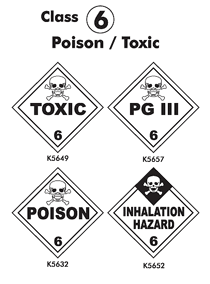
- Classifications
- Toxic 6: Toxic material that poses an oral or dermal hazard.
- PG III 6: Toxic material in packing group III.
- Poison 6: Toxic material that poses an oral or dermal hazard.
- Inhalation Hazard: Toxic material that poses an inhalation hazard.
- Division 6.1 Toxic Substances
- includes toxic substances, poisons, and irritating materials. Toxic substance is a poisonous material, other than a gas, that is known to be so toxic to humans as to cause death, injury or harm to human health if swallowed, inhaled or brought into contact with skin.
- Division 6.2 Infectious Substance
- It means a material known or reasonably expected to contain a pathogen. A pathogen is a micro-organism that can cause disease in humans or animals.
- For POISON (PGl or PGII, other than inhalation hazard) and POISON (PGIII), placard 454 kg (1,001 lbs) or more. For POISON-INHALATION HAZARD (Division 6.1), inhalation hazard only, placard any quantity.
Hazard Class 7: Radioactive Materials
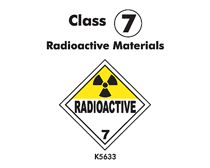
- Radioactive materials contain charged particles (ions) and have an specific activity greater than 0.002 micro curies per gram. These charged particles may cause damage to molecules, cells or tissue. Atoms that emit ionizing radiation are said to be radioactive; radioactivity is the process whereby atomic changes, known as decay or disintegration, occur through the emission of ionizing radiation.
- Any quantity of packages bearing the RADIOACTIVE YELLOW III label (LSA-III). Some radioactive materials in "exclusive use" with low specific activity radioactive materials will not bear the label, however, the RADIOACTIVE placard is required.
Hazard Class 8: Corrosive
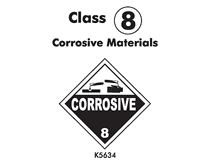
- A CORROSIVE material (Class 8) means a liquid or solid that causes full thickness destruction of human skin at the site of contact within a specified period of time; or a liquid that exhibits a corrosion rate on steel or aluminum surfaces exceeding 6.25 mm (0.25 inch) a year at a test temperature of 55°C (130°F).
- For CORROSIVE, placard 454 kg (1,001 lbs) or more.
Hazard Class 9: Misc. Dangerous Goods
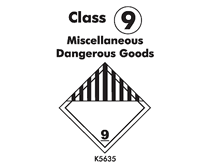
- A material which presents a hazard during transportation but which does not meet the definition of any other hazard class.
- Not required for domestic transportation. A bulk packaging containing a Class 9 material must be marked with the appropriate ID number displayed on a Class 9 placard, an orange panel, or a white square-on-point display.
Dangerous Mixed Loads
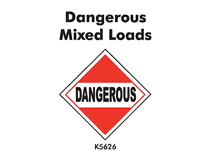
A freight container, unit load device, transport vehicle, or rail car which contains non-bulk packages with two or more categories of hazardous materials that require different placards may be placarded with DANGEROUS placards instead of the specific placards. However, when 1,000 kg (2,205 lbs) or more of one category of material is loaded at one loading facility, the specific placard must be applied.
Identification Number Displays
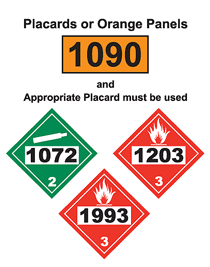
- MUST BE DISPLAYED ON
- Tank Cars, Cargo Tanks, Portable Tanks, and other Bulk Packaging;
- Vehicles or containers containing 4,000 kg (8,820 lbs) in non-bulk packages of only a single hazardous material having the same proper shipping name and identification number; and
- 1,000 kg (2,205 lbs) of materials poisonous by inhalation in Hazard Zone A or B.
